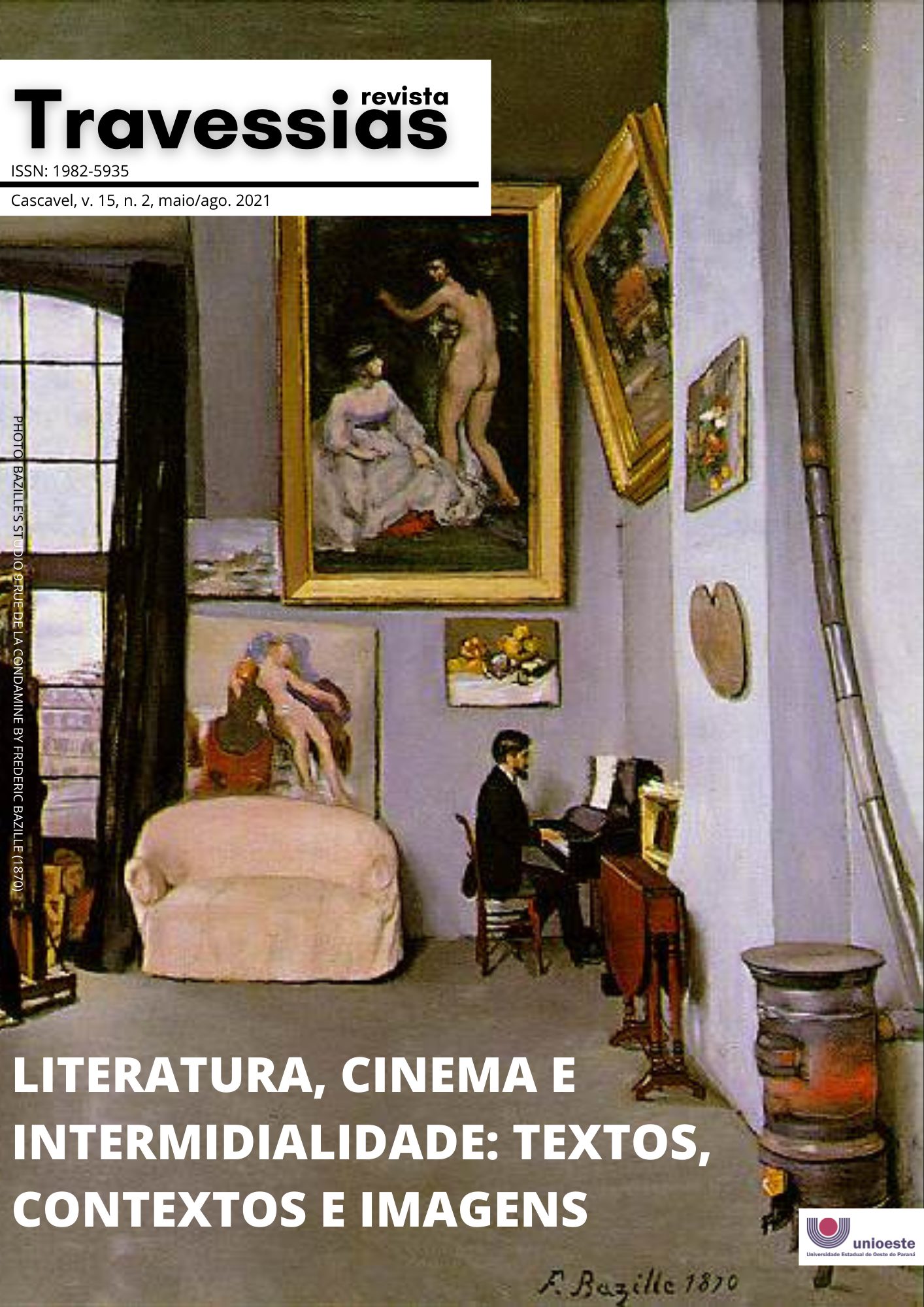A becoming cinamtographic narrative
DOI:
https://doi.org/10.48075/rt.v15i2.27782Keywords:
Intermediality, Sérgio Sant’Anna, Time-Image.Abstract
The innovative character of Sérgio Sant'Anna's work has been highlighted by critics, among other factors, for its fluid boundaries between the literary and other languages. From this perspective, the present paper examines the intermediality with cinema of his O conto zero e outras histórias, 2016, taking into account intermedia concepts and general fundamentals regarding filmic language, as well as theoretical foundations about the contacts of this language with literature. It analyzes the stories separately and the book as a whole to point out relations of continuity and rupture, inherent to the components of the narrative. From these analyses, the paper postulates that the book simulates the dynamics of modern cinematographic narrative, as pondered by Gilles Deleuze in his works Movement-image and Time-image.
Downloads
References
AMIEL, Vincent. Estética da montagem. Lisboa: Texto & Grafia, 2011.
BALÁZS, Béla. Theory of the film: character and growth of a new art. London: Dennis Dobson Ltd, 1952.
BALÁZS, Béla. Early Film Theory: Visible Man and The Spirit of Film. New York: Berghahn, 2011.
BAZIN, André. O cinema: ensaios. Tradução Eloísa de Araújo Ribeiro. São Paulo: Brasiliense, 1991.
BENVENISTE, Émile. Problemas de linguística geral. Tradução de Maria da Glória Novak e Luiza Neri. São Paulo: Ed Universidade de São Paulo, 1976.
DELEUZE, Gilles. A imagem-movimento. Tradução Stella Serna. São Paulo: Brasiliense, 1985.
DELEUZE, Gilles. A imagem-tempo. Tradução Eloísa de Araújo Ribeiro. São Paulo: Brasiliense, 2005.
EISENSTEIN, Sergei. A forma do filme. Tradução de Teresa Ottoni. Rio de Janeiro: Jorge Zahar, 2002.
ELLESTRÖM, Lars A medium-centered model of communication, Semiótica, Berlin, vol. 2018, no. 224, pp. 269-293, Dec 2016.
FIGUEIREDO, Vera Lúcia Follain de. Narrativas migrantes: literatura roteiro e cinema. Rio de Janeiro: Ed PUC-Rio, 2010.
FLUDERNIK, Monika. The Fictions of Language and the Languages of Fiction: The Linguistic Representation of Speech and Consciousness. New York: Routledge, 1993.
HUMPHREY, Robert. O fluxo de consciência. São Paulo: McGraw-Hill do Brasil, 1976.
MARTIN, Marcel. A linguagem cinematográfica. Tradução Lauro António e Maria Eduarda Colares. Lisboa: Dinalivro, 2005.
MÜNSTERBERG, Hugo. The Photoplay: A Psychological Study. (New York: D. Appleton and Company, 1916) The Gutenberg Project, 2005.
MURRAY, Edward. The Cinematic Imagination: Writers and the Motion. Pictures. New York: Frederick Ungar, 1972.
PIETARINEN, Ahti-Veikko. Grice in the wake of Peirce, Pragmatics and Cognition, Amsterdam, v. 12, n. 2, p. 295-315, dez. 2004.
RAJEWSKY, Irina. Intermedialität. Tübingen/Basel: A. Francke, 2002.
RAJEWSKY, Irina. Intermediality, Intertextuality, and Remediation: A Literary Perspective on Intermediality, Intermédialités. Histoire et théorie des arts, des lettres et des techniques (Érudit), Montreal, no 6, pp 43-64, Fall 2005.
SANT’ANNA, Sérgio. O conto zero e outras histórias. Edição Kindle, 2016.
SOUZA, Valéria Viana de. Os (des)caminhos do você. 2008. 220 f. Tese (Doutorado em Letras). Faculdade de Letras. Universidade Federal da Paraíba, 2008.
SÜSSEKIND, Flora. Cinematógrafo de letras: literatura, técnica e modernização no Brasil. São Paulo: Companhia das Letras, 1987.
Downloads
Published
How to Cite
Issue
Section
License
Creative Copyright Notice
Policy for Free Access Journals
Authors who publish in this journal agree to the following terms:
1. Authors keep the copyright and grant the journal the right of first publication, with the work simultaneously licensed under the Creative Commons Attribution License, which allows sharing the trial with acknowledgment of authorship and initial publication in this journal.
2. Authors are authorized to take additional contracts separately, for non-exclusive distribution of the work version, published in this journal (eg publish in institutional repository or as a book chapter), with acknowledgment of authorship and initial publication in this journal.
3. Authors are allowed and encouraged to publish and distribute their work online (eg in institutional repositories or on their personal page) at any point before or during the editorial process, as this can generate productive changes, as well as increase both impact and citation of the published trial (See The Effect of Free Access).
Creative Commons License
This work is licensed under a Creative Commons Attribution–NonCommercial-shareaswell 4.0 International License, which allows you to share, copy, distribute, display, reproduce, completely or part of the work, since there is no commercial purpose, and authors and source are cited.



